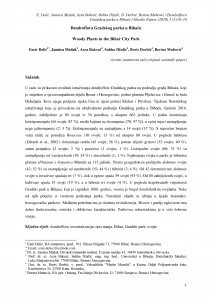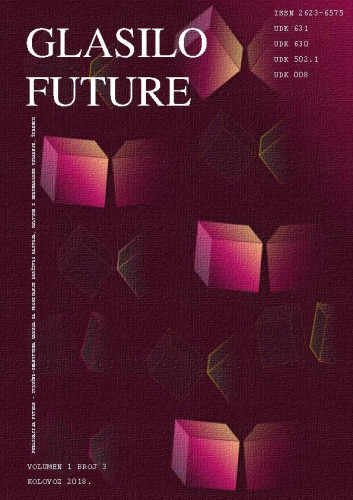U radu su prikazani rezultati istraživanja dendroflore Gradskog parka na području grada Bihaća, koji je smješten u sjeverozapadnom dijelu Bosne i Hercegovine, podno planina Plješevice i Grmeč te brda Debeljača. Kroz njega protječu rijeka Una te njeni pritoci Klokot i Privilica. Tijekom florističkog istraživanja koje je provedeno na obuhvatnom području Gradskog parka u Bihaću, tijekom 2016. godine, zabilježeno je 80 svojti iz 30 porodica, s ukupno 663 jedinke. U parku dominiraju kritosjemenjače (66 svojti; 83 %), među kojima su dvosupnice (78; 97 %), u većoj mjeri zastupljenije nego jednosupnice (2; 3 %). Golosjemenjače su zastupljene s 14 svojti (17 %). S najvećim brojem vrsta ističe se porodica Rosaceae (10 svojti; 13 %) od ukupno 80 svojti. U pogledu habitusa (Erhardt et al., 2002.) dominiraju stabla (45 svojti; 56 %), potom slijede grmovi (32 svojte; 40 %), zatim penjačice (2 svojte; 3 %) i puzavice (1 svojta; 1 %). Listopadne svojte (60; 75 %) su zastupljenije od vazdazelenih (19; 24 %) i zimzelenih (1; 1 %). Najbrojnija svojta u parku je hibridna platana (Platanus x hispanica Münch) sa 115 jedinki. Prema geografskom podrijetlu alohtone svojte (42; 52 %) su zastupljenije od autohtonih (35; 44 %) i hibrida (3; 4 %). Od 42 determinirane alohtone svojte u invazivne spadaju tri (7 %), dok u egzote spada 39 svojti (93 %). Od 80 zabilježenih svojti, u kultivare spada 15 svojti (19 %), a u hibride tri svojte (4 %). U pogledu krajobraznih vrijednosti Gradski park u Bihaću, koji je izgrađen 1888. godine, veoma je bogat dendrološkim svojtama. Neke od njih potječu iz vremena podizanja parka.; The paper presents the findings of a research on woody plants in the city park of the city of Bihać, located in the north-western part of Bosnia and Herzegovina, under the mountains Plješevica and Grmeč, as well as under Debeljača hill. The Una River and its tributaries Klokot and Privilica flow through the city. Throughout the floristic research study conducted in the area covered by the city park in Bihać, in 2016, 80 plant species from 30 families were identified, comprising of a total of 663 individual plants. Angiospermae (66 species; 83%) are the most dominant in the park, among which Dicotyledonae (78; 97%) were identified, which have a significantly greater share compared with Monocotyledonae (2; 3%). There are 14 species of Gymnospermae (17%). Rosaceae family stands out with the largest number of species (10 species; 13%) of a total 80 plant species. Concerning the growth form (according to Erhardt et al., 2002) trees are dominant (45 species; 56%), followed by shrubs (32 species; 40%), climbers (2 species; 3%) and creepers (1 species; 1%). Deciduous species (60; 75%) have a higher share compared with evergreens (19; 24%) and conifers (1; 1%). The most widespread species in the park is a hybrid plane species (Platanus x hispanica Münch) with 115 trees. According to geographical origin, allochthonous species (42; 52%) are more widespread in relation to autochthonous species (35; 44%) and hybrids (3; 4%). Out of 42 identified allochthonous species, 3 are invasive species (7%), while there are 39 species (93%) of exotic plants. Out of 80 identified species, 15 species (19%) are cultivars, while 3 species (4%) are hybrids.
Sažetak

 Glasilo Future : stručno-znanstveni časopis 1,3(2018) / glavni i odgovorni urednik Boris Dorbić.
Glasilo Future : stručno-znanstveni časopis 1,3(2018) / glavni i odgovorni urednik Boris Dorbić.